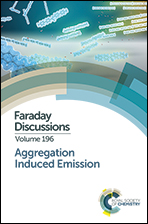Aggregation-induced enhanced green light emission from a simple donor–π–acceptor (D–π–A) material: a structure–property relationship study†
Abstract
Organic D–π–A materials, possessing intramolecular charge transfer, have attracted much scientific attention in recent years because of their potential applications in the development of organic light emitting devices (OLEDs). Two new compounds, A1 and A2, having a D–π–A skeleton have been synthesized and single crystals were grown by the solution growth technique. Both compounds were characterized for crystallographic, thermal and photophysical properties. Upon photo-excitation in the solid state, A1 showed very strong green light emission while A2 gave sky-blue emission with much lower intensity. A single crystal X-ray diffraction study revealed that in the crystal lattice of A1, both the donor and acceptor groups are involved in the intermolecular interactions. This results in the restricted intramolecular rotation (RIR) of the D and A moieties, and enables A1 to emit more intensely in the solid state due to aggregation-induced emission (AIE). Intense green light emission, along with a good crystalline nature indicates that A1 might be a potential candidate for opto-electronic devices.
- This article is part of the themed collection: Aggregation Induced Emission

 Please wait while we load your content...
Please wait while we load your content...